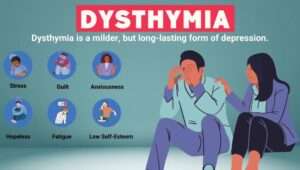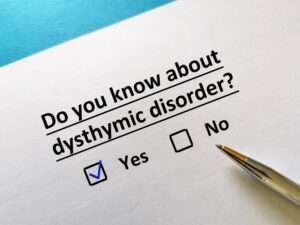Dysthymic Disorder
Dysthymic disorder is an ongoing low mood condition, sometimes called Persistent Depressive Disorder. It causes persistent feelings of sadness over long periods. Unlike major depression, it has less severe symptoms that last longer, affecting many parts of your life.
Table of Contents
- Introduction
- Signs and symptoms
- Causes
- Diagnosis
- Treatment and Management
- Coping Strategies
- Impact on Daily Life
- Risk Factors
- Complications
- Prevention Strategies
- Misconceptions
- Seeking Help
- Research and Developments
- Personal Stories and Insights
- Conclusion
What is dysthymic disorder?
Definition of Dysthymic Disorder
People often feel low or sad for a long time due to dysthymic disorder. This type of chronic depression lasts two years or more. People with dysthymic disorder feel hopeless, uninterested, and lack joy in daily activities. Even though dysthymic disorder symptoms seem less severe than major depression, it still impacts quality of life greatly. The chronic sadness affects how a person functions normally.
dysthymic disorder meaning
Dysthymic disorder is a type of depression. Let’s understand what the term means:
- Dys: This part of the word often means “abnormal” or “difficult.”
- Thymic: This refers to mood, even though it doesn’t directly connect to the thymus gland (an immune system organ).
- Disorder: This indicates a disruption or imbalance in how something normally functions.
dysthymic disorder pronunciation
It is pronounced “dis-thi-mik dis-or-der.” Another name is persistent depressive disorder.
Causes of Dysthymic Disorder
Dysthymic disorder arises from factors combining. These factors include genes, physical aspects, environment, and mindset. Here’s what might play a role:
- Genetics: Genetics contribute. Having family with depression or mood disorders raises your risk.
- Brain Chemistry: Brain chemicals that control mood, like serotonin and norepinephrine, being out of balance, plays a part in dysthymic disorder. These imbalances could impact how a person feels.
- Life Events: Tough life events like losing someone close, relationship troubles, or money worries, might cause the symptoms or make them worse. Stressful situations take a toll.
- Personality Factors: How someone sees themselves and the world affects the chances of dysthymic disorder. If overly self-critical or pessimistic, this increases the risk. Personality traits influence mental health.
Symptoms of Dysthymic Disorder

Dysthymic disorder is characterized by the following primary signs and symptoms:
- Low Mood: You feel gloomy, crummy, hopeless – like a rain cloud won’t leave.
- Loss of Interest: Those hobbies and fun times? No spark anymore. It’s a total bummer.
- Fatigue: Feeling worn out, depleted of vigor, even after adequate rest.
- Poor Concentration: Troubles focusing thoughts, making choices, recalling things.
- Appetite Changes: Major appetite fluctuations – overeating or undereating.
- Sleep Disturbances: Sleep disruptions – excessive slumber or insomnia.
- Low Self-Esteem: Diminished self-worth, low sense of personal value.
- Social Withdrawal: Retreating from socialization, evading interpersonal engagements.
- Hopelessness: Pessimism about the future, despair of improvement.
- Irritability: Quick to irritation, readily vexed, even by trifles.
Diagnosis of Dysthymic Disorder

When you have dysthymic disorder, it’s crucial to get an in-depth evaluation. Your healthcare provider, like a doctor or counselor, will conduct this. Here’s what happens during diagnosis:
Clinical Evaluation:
The provider asks about your symptoms, medical background, and family’s mental health history. This comprehensive review is key.
Diagnostic Criteria:
Dysthymic disorder gets diagnosed based on certain rules set in the Diagnostic and Statistical Manual of Mental Disorders (DSM-5). These rules require having sad feelings for no less than two years.
Physical Exam:
Doctors may check your body to ensure no illness causes your low mood. This physical exam helps rule out medical conditions.
Psychological Assessment:
Tests or surveys evaluate symptom severity. These assessments examine how much symptoms disrupt daily life. Psychologists use these tools to understand dysthymic disorder better.
Treatments for Dysthymic Disorder

Frequent treatment options for this disorder encompass:
Psychotherapy:
Chat sessions like CBT and interpersonal counselling assist folks in developing techniques for handling stress. They encourage questioning unhealthy ways of thinking, fostering more positive perspectives and behaviors. It allows individuals to acquire more adaptive coping mechanisms.
Medication:
Some medicines can help manage mood. These are antidepressants like SSRIs and SNRIs. They work by regulating brain chemicals linked to mood. These meds may ease symptoms of depression or anxiety.
Lifestyle Changes:
Healthy habits play a big role too. Moving your body through exercise is key. Getting quality sleep and eating balanced meals also matter. Finding ways to de-stress, like yoga or mediation, can lift your spirits.
Support Groups:
Connecting with others facing comparable situations may offer vital encouragement and companionship. Support groups can provide a steady source of reassurance and guidance.
Regular Monitoring:
Tracking recovery alongside medical professionals remains crucial. Frequent check-ins allow adjusting care plans as required, helping sustain progress and avert potential setbacks. Consistent monitoring and follow-up are paramount.
Medications for Dysthymic Disorder
Medications often play a crucial role in treating dysthymic disorder. Common prescriptions comprise:
1: Selective Serotonin Reuptake Inhibitors (SSRIs):
Those drugs, like Prozac, Zoloft, and Lexapro, work by boosting serotonin in your brain. Serotonin helps lift your mood and ease depression. These meds get prescribed a lot since they do that.
2: Serotonin-Norepinephrine Reuptake Inhibitors (SNRIs):
SNRIs make more serotonin and norepinephrine in the brain. Venlafaxine and duloxetine are SNRIs. They help with depression symptoms. The increased brain chemicals can make people feel better.
3: Tricyclic Antidepressants (TCAs):
Older drugs called TCAs can treat depression well. These include amitriptyline (Elavil) and nortriptyline (Pamelor). But, TCAs often cause more side effects compared to newer antidepressants. So, doctors may not prescribe them as frequently nowadays.
4: Monoamine Oxidase Inhibitors (MAOIs):
Some people take monoamine oxidase inhibitors (MAOIs) for dysthymia. These anti-depressants are medications that could work. Nardil and Parnate are brand names for phenelzine and tranylcypromine. But, you need to watch what you eat and drink when taking MAOIs. Foods and drugs can dangerously interact with these pills.
5: Atypical Antidepressants:
Bupropion, sold as Wellbutrin, and Mirtazapine, marketed under Remeron, work differently than SSRIs/SNRIs. Though unconventional antidepressants, both drugs can effectively combat depression.
Impact of Dysthymic Disorder on Daily Life
Dysthymic disorder can deeply impact daily life.
- Mood and Emotions: Emotions may feel heavy, with sadness, hopelessness, and emptiness lingering constantly. Finding joy becomes difficult. Emotional well-being suffers.
- Work and School: At work or school, concentration wanes. Low energy and lacking motivation hinder productivity. Academic or professional struggles arise.
- Relationships: Relationships strain under dysthymic disorder’s weight. Withdrawal, irritability, and communication barriers create rifts with family, friends, and romantic partners.
- Self-Care: Self-care can become difficult. Basic tasks, like grooming, hygiene, and chores, might feel too much. Low motivation and lack of energy make them hard.
- Social Activities: Withdrawing from activities and spending time alone often happens. This can make you feel very lonely and disconnected from others. It worsens depression symptoms too.
- Physical Health: Physical problems may arise. The dysthymic disorder causes persistent stress and depression. Things like headaches, stomach issues, and weaker immunity can develop from this condition.
dysthymic disorder vs depression
Dysthymic Disorder ICD-10
The ICD-10 classifies dysthymic disorder under F34.1. It falls into persistent mood disorders. A chronic low mood lasts at least two years. It also includes symptoms like poor appetite, overeating, sleep issues, low energy, fatigue, and low self-esteem. This mood disorder involves a long-lasting depressed state with various other problems.

Pingback: Persistent Depressive Disorder (Dysthymia)